
The Place de la Concorde is one of the major public squares in Paris, France Measuring 7.6 hectares in area, it is the largest square in the French capital. It is located in the city's eighth arrondissement, at the eastern end of the Champs-Élysées. It was the site of many notable public executions during the French Revolution.

Cleopatra's Needle is the popular name for each of three Ancient Egyptian obelisks re-erected in London, Paris, and New York City during the nineteenth century. The obelisks in London and New York are a pair; the one in Paris is also part of a pair originally from a different site in Luxor, where its twin remains. Although all three needles are genuine Ancient Egyptian obelisks, their shared nickname is a misnomer, as they have no connection with the Ptolemaic Queen Cleopatra VII of Egypt and were already over a thousand years old in her lifetime. An earlier reference states Queen Cleopatra bought the London obelisk from Heliopolis to Alexandria shortly before the time of Christ for the purpose of decorating a new temple but it was never erected and lay buried in sand on the shore until given to the British in 1820. The London and New York needles were originally made during the reign of the 18th Dynasty Pharaoh Thutmose III. The Paris needle dates to the reign of the 19th Dynasty Pharaoh Ramesses II, and was the first to be moved and re-erected. The New York needle was the first to acquire the French nickname, "L'aiguille de Cléopâtre", when it stood in Alexandria.

Egyptian revival is an architectural style that uses the motifs and imagery of ancient Egypt. It is attributed generally to the public awareness of ancient Egyptian monuments generated by Napoleon's conquest of Egypt and Admiral Nelson's defeat of Napoleon at the Battle of the Nile in 1798. The size and monumentality of the façades 'discovered' during his adventure cement the hold of Egyptian aesthetics on the Parisian elite. Napoleon took a scientific expedition with him to Egypt. Publication of the expedition's work, the Description de l'Égypte, began in 1809 and was published as a series through 1826. However, works of art and architecture in the Egyptian style had been made or built occasionally on the European continent and the British Isles since the time of the Renaissance.

St. Peter's Square is a large plaza located directly in front of St. Peter's Basilica in the Vatican City, the papal enclave inside Rome, directly west of the neighbourhood or rione of Borgo. Both the square and the basilica are named after Saint Peter, an apostle of Jesus considered by some to be the first Pope.

The Lincoln Tomb is the final resting place of the 16th President of the United States, Abraham Lincoln, his wife, Mary Todd Lincoln, and three of their four sons, Edward, William, and Thomas. It is located in Oak Ridge Cemetery in Springfield, Illinois. Constructed of granite, the tomb has a single-story rectangular base, surmounted by an obelisk, with a semicircular receiving room entrance-way, on one end, and semicircular crypt or burial room on the opposite side.

The Mounted Memorial, Canberra is on Anzac Parade, the principal ceremonial and memorial avenue in Canberra, the national capital city of Australia. It is a copy of a memorial that was originally constructed in Port Said in 1932 but removed in 1956; a second copy was erected at Mount Clarence, Western Australia.
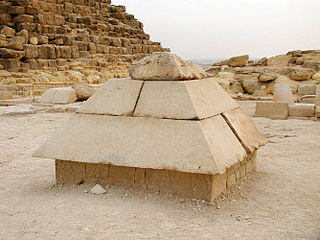
Benben was the mound that arose from the primordial waters Nu upon which the creator deity Atum settled in the creation myth of the Heliopolitan form of ancient Egyptian religion. The Benben stone is the top stone of the pyramid. It is also related to the Obelisk.

El Qantara is a northeastern Egyptian city on both sides of the Suez Canal, in the Egyptian governorate of Ismailia, 160 kilometres (99 mi) northeast of Cairo and 50 kilometres (31 mi) south of Port Said. The two parts of the city are connected by a high-level fixed road bridge, the Mubarak Peace Bridge.

Many Unknown Soldier Memorials for Egyptian and Arab soldiers were constructed inside and outside Egypt. The most famous is the one in Cairo.
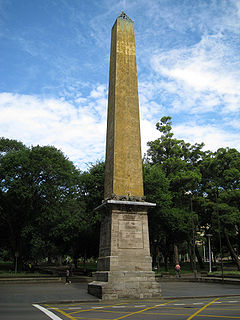
The Hyde Park Obelisk is a heritage-listed obelisk that served as a sewer vent and is now a monument located in Hyde Park at the intersection of Elizabeth Street and Bathurst Street, in the Sydney central business district, in the City of Sydney local government area of New South Wales, Australia. It was designed and built by the NSW Department of Public Works. It is also known as The Obelisk and Obelisk Sewer Vent. It is also jokingly referred to as Thornton's Scent Bottle. The obelisk is owned by Sydney Water, an agency of the Government of New South Wales. It was added to the New South Wales State Heritage Register on 15 November 2002.

Mataria is a district in the northern region of Greater Cairo, east of the Nile, in Egypt. The district is unrelated to the coastal town in the Dakahlia Governorate, that is also named El Matareya. The district's location was part of the ancient city of Heliopolis, one of the oldest cities of ancient Egypt.

Agnes Prest was an English Protestant martyr from the reign of the Catholic Queen Mary. She was burned at the stake at Southernhay in Exeter in 1557. According to Foxe's Book of Martyrs, and the story of Exeter Protestant Martyrs she lived near Launceston, Cornwall, and was married to a Catholic husband. She left her husband over his Catholicism, and went to be a spinner but she later on returned to him and was arrested and indicted at the Launceston Assizes. She was then put in Launceston jail and then transferred to Exeter jail. In Exeter prison, she was brought before the Bishop of Exeter, bishop Turbeville. When questioned, she denied the Catholic doctrine of Transubstantiation. She was then released for a month. Whilst she was released, she is said to have met a Dutch stonemason in Exeter Cathedral who was repairing the statues of the saints beloved of the Catholics. According to Foxe, she said to him "What a madman art thou, to make them new noses, which within a few days shall all lose their heads". After that point she was returned to jail where she had many visitors, including Walter Raleigh's mother, Catherine Raleigh who praised her for her 'Godly life'. She was then tried for heresy by the Mayor of Exeter, refused to recant her beliefs and was executed by being burnt to death on the 15th August 1557.
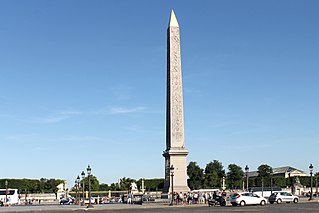
The Luxor Obelisk is a 23 metres (75 ft) high Ancient Egyptian obelisk standing at the centre of the Place de la Concorde in Paris, France. It was originally located at the entrance to Luxor Temple, in Egypt. The Luxor Obelisk was classified as a historical monument in 1936.

Thomas Benet from Cambridge, was an English Protestant martyr during the reign of King Henry VIII. In 1524, he moved to Torrington, North Devon, with his wife and family so that he could exercise his religious conscience more freely in a county where no one knew him. He was executed by burning on 15 January 1531, for heresy, at Livery Dole outside Exeter in Devon, under the supervision of Sir Thomas Dennis (c.1477-1561) of Holcombe Burnell, near Exeter, then Sheriff of Devon.
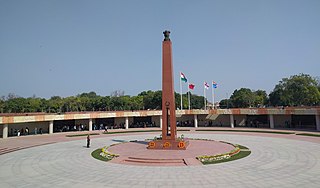
The National War Memorial is a monument constructed by the Government of India in the vicinity of the India Gate, New Delhi, to honour its Armed Forces. The memorial is spread over 40 acres and is made around the existing chhatri (canopy) near India Gate. The memorial wall is flushed with the ground and in harmony with existing aesthetics. Names of martyrs during 1947–48, 1961 (Goa), 1962 (China), 1965, 1971, 1987 (Siachen), 1987-88, 1999 (Kargil), and other operations such as Operation Rakshak, are inscribed on the memorial walls.
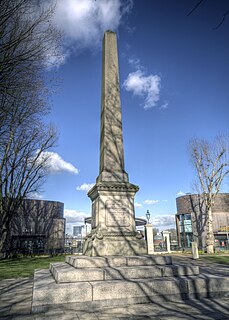
The New Zealand Memorial is an obelisk in Greenwich which commemorates 21 British officers and men of the Royal Navy who died in the New Zealand War of 1863–64. The memorial is located near the River Thames, east of the Cutty Sark, close to the Royal Naval College, Greenwich. It became a Grade II listed building in 1973.

Mersin Martyrs' Memorial, also known as the Monument of the Refah Martyrs is a monument in Mersin, Turkey
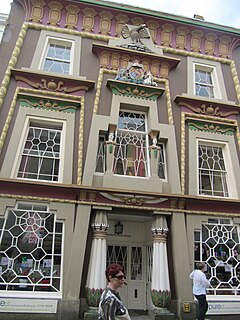
Egyptian Revival architecture in the British Isles is a survey of motifs derived from Ancient Egyptian sources occurring as an architectural style. Egyptian Revival architecture is comparatively rare in the British Isles. Obelisks start appearing in the 17th century, mainly as decorative features on buildings and by the 18th century they started to be used in some numbers as funerary or commemorative monuments. In the later 18th century, mausoleums started to be built based on pyramids, and sphinxes were used as decorative features associated with monuments or mounted on gate piers. The pylon, a doorway feature with spreading jambs which support a lintel, also started to be used and became popular with architects.



















